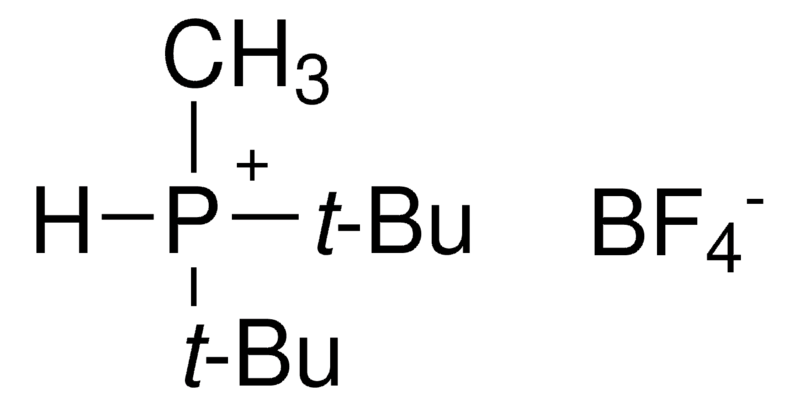DI-TERT-BUTYLMETHYLPHOSPHONIUM TETRAFLUOROBORATE CAS#: 479094-62-7; ChemWhat Code: 36585
Identification
| Product Name | DI-TERT-BUTYLMETHYLPHOSPHONIUM TETRAFLUOROBORATE |
| IUPAC Name | ditert-butyl(methyl)phosphanium;tetrafluoroborate |
| Molecular Structure |  |
| CAS Registry Number | 479094-62-7 |
| EINECS Number | No data available |
| MDL Number | No data available |
| Beilstein Registry Number | No data available |
| Synonyms | Butyl[bis(2-methyl-2-propanyl)]phosphonium tetrafluoroborate [ACD/IUPAC Name] Butyl[bis(2-methyl-2-propanyl)]phosphoniumtetrafluoroborat [German] [ACD/IUPAC Name] Tétrafluoroborate de butyl[bis(2-méthyl-2-propanyl)]phosphonium [French] [ACD/IUPAC Name] |
| Molecular Formula | C9H22BF4P |
| Molecular Weight | 248.05 |
| InChI | InChI=1S/C9H21P.BF4/c1-8(2,3)10(7)9(4,5)6;2-1(3,4)5/h1-7H3;/q;-1/p+1 |
| InChI Key | BRDLRXCAHKUWJS-UHFFFAOYSA-O |
| Canonical SMILES | CPH+C)C(C)(C)C.FB-(F)F |
| Patent Information | |
| No data available |
Physical Data
| Appearance | White to Off-white crystalline powder |
| Solubility | No data available |
| Flash Point | No data available |
| Refractive index | No data available |
| Sensitivity | No data available |
Spectra
| No data available |
Route of Synthesis (ROS)
| No data available |
Safety and Hazards
| Pictogram(s) |   |
| Signal | Danger |
| GHS Hazard Statements | H314 (88.4%): Causes severe skin burns and eye damage [Danger Skin corrosion/irritation] H315 (11.6%): Causes skin irritation [Warning Skin corrosion/irritation] H319 (11.6%): Causes serious eye irritation [Warning Serious eye damage/eye irritation] H335 (11.6%): May cause respiratory irritation [Warning Specific target organ toxicity, single exposure; Respiratory tract irritation] Information may vary between notifications depending on impurities, additives, and other factors. |
| Precautionary Statement Codes | P260, P261, P264, P264+P265, P271, P280, P301+P330+P331, P302+P352, P302+P361+P354, P304+P340, P305+P351+P338, P305+P354+P338, P316, P319, P321, P332+P317, P337+P317, P362+P364, P363, P403+P233, P405, and P501 |
Other Data
| Transportation | NONH for all modes of transport |
| For short-term storage, it can be stored in a conventional sealed container (within 6 months) | |
| HS Code | 290621 |
| Storage | The product slowly oxidizes when exposed to air. For long-term storage, it needs to be vacuum packed and refrigerated (more than 2 years) |
| Shelf Life | 1 year |
| Market Price | USD |
| Druglikeness | |
| Lipinski rules component | |
| Molecular Weight | 248.052 |
| logP | 7.291 |
| HBA | 0 |
| HBD | 0 |
| Matching Lipinski Rules | 3 |
| Veber rules component | |
| Polar Surface Area (PSA) | 13.59 |
| Rotatable Bond (RotB) | 2 |
| Matching Veber Rules | 2 |
| Use Pattern |
| The complex of the large sterically hindered phosphine ligand and the precious metal palladium is a highly active C-C and C-N coupling reaction catalyst, which can efficiently catalyze the coupling reaction of aryl chloride with aryl boronic acid or aryl amine. |
Buy Reagent | |
| No reagent supplier? | Send quick inquiry to ChemWhat |
| Want to be listed here as a reagent supplier? (Paid service) | Click here to contact ChemWhat |
Approved Manufacturers | |
| Want to be listed as an approved manufacturer (Requires approvement)? | Please download and fill out this form and send back to approved-manufacturers@chemwhat.com |
Contact Us for Other Help | |
| Contact us for other information or services | Click here to contact ChemWhat |
